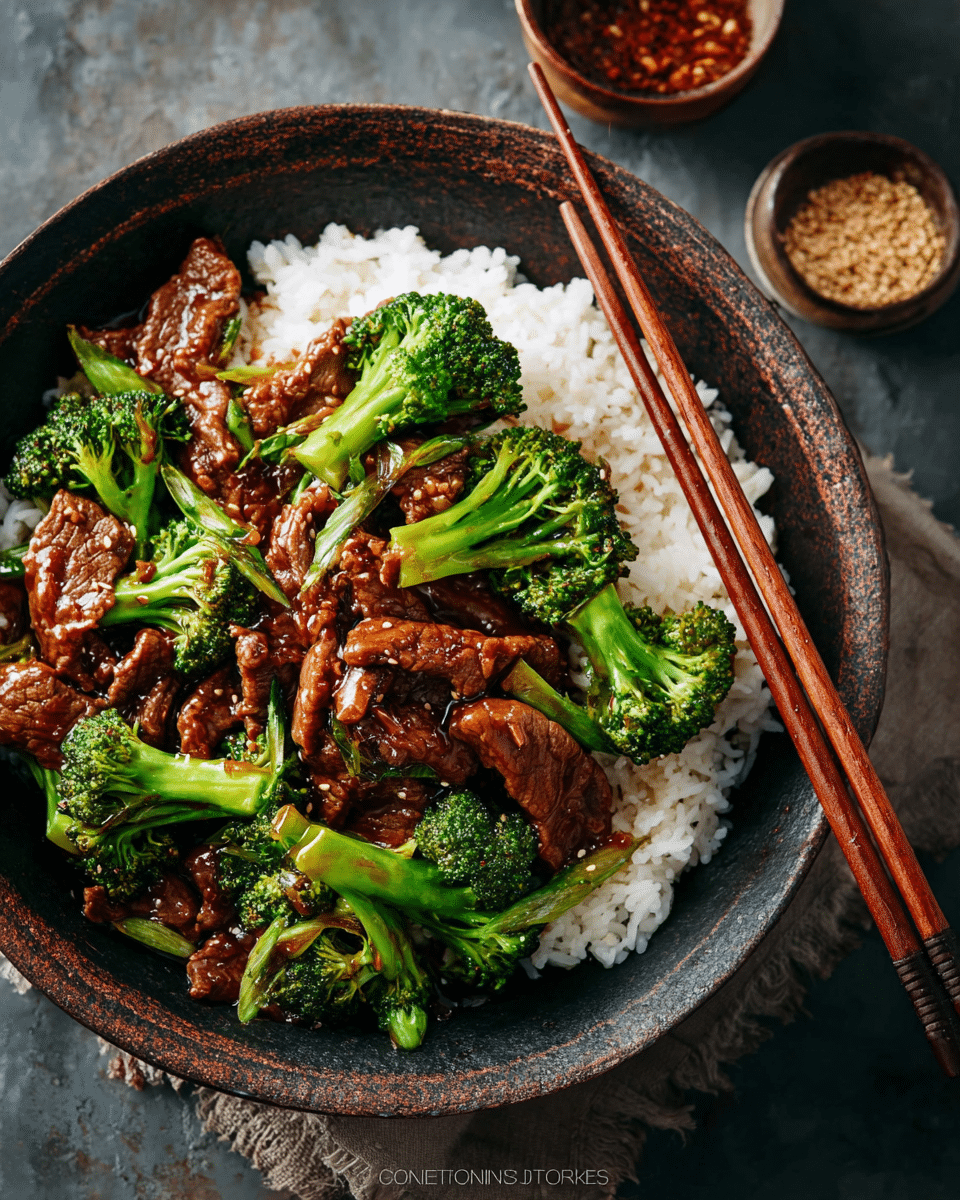Chinese Beef and Broccoli is a classic dish that balances tender slices of beef with crisp, fresh broccoli, all enveloped in a savory garlic sauce. The combination of umami flavors, slight sweetness, and aromatic ginger creates a dish that’s both comforting and satisfying.
This recipe is perfect for busy weeknights because it’s quick to prepare and versatile. Serve it over steamed rice or noodles for a complete meal, or pair it with other Asian-inspired sides for a flavorful spread. Its simplicity and bold flavors make it a go-to for home cooks seeking a restaurant-quality experience in their own kitchen.
Full Recipe:
Ingredients:
-
1 lb (450g) flank steak, thinly sliced against the grain
-
4 cups broccoli florets
-
3 tablespoons soy sauce
-
2 tablespoons oyster sauce
-
2 tablespoons cornstarch
-
1 tablespoon rice vinegar
-
1 tablespoon sesame oil
-
2 teaspoons sugar
-
3 cloves garlic, minced
-
1 teaspoon fresh ginger, minced
-
1/4 cup beef or chicken broth
-
2 tablespoons vegetable oil
Directions:
-
In a small bowl, combine soy sauce, oyster sauce, cornstarch, rice vinegar, sesame oil, sugar, and broth to make the sauce. Set aside.
-
Heat 1 tablespoon vegetable oil in a large skillet or wok over medium-high heat. Add the sliced beef and stir-fry for 2-3 minutes until browned but not fully cooked. Remove beef and set aside.
-
Add remaining oil to the skillet. Sauté garlic and ginger for about 30 seconds until fragrant.
-
Add broccoli florets and stir-fry for 2-3 minutes, until tender-crisp.
-
Return the beef to the skillet and pour in the prepared sauce. Stir-fry together for another 2 minutes until beef is cooked through and sauce has thickened.
-
Serve hot with steamed rice or noodles.
Prep Time: 15 minutes | Cooking Time: 15 minutes | Total Time: 30 minutes
Kcal: 350 kcal | Servings: 4 servings
Chinese Beef and Broccoli is one of those quintessential dishes that have become a staple in Chinese-American cuisine. With its tender slices of beef, vibrant green broccoli, and a perfectly balanced savory sauce, it offers a harmonious combination of textures and flavors. This dish is not only visually appealing but also incredibly satisfying, making it a favorite for both weeknight dinners and special occasions. Its rich umami notes, lightly sweet undertones, and subtle garlic and ginger aromatics make it universally appealing.
Origins and Cultural Background
Beef and broccoli, as we know it today, has roots in Chinese-American cooking. While beef stir-fries exist in traditional Chinese cuisine, the pairing of beef with broccoli in a savory oyster sauce is largely an American adaptation. Chinese immigrants in the United States developed this recipe using locally available ingredients while maintaining the essence of traditional Chinese cooking techniques like stir-frying over high heat. Over the decades, it has evolved into a comfort food classic, bridging authentic Chinese flavors with American tastes.
Flavor Profile and Cooking Technique
The key to Chinese Beef and Broccoli lies in achieving a perfect balance between the beef and broccoli. The beef should be tender, juicy, and infused with the savory sauce, while the broccoli must remain crisp and vibrant. The sauce itself is a combination of soy sauce, oyster sauce, sesame oil, sugar, and a bit of broth, delivering both umami richness and subtle sweetness. Aromatics such as garlic and ginger add depth and fragrance, elevating the dish to restaurant-quality standards. The stir-fry technique, which involves cooking ingredients quickly over high heat, ensures that flavors meld beautifully while maintaining the integrity and texture of each component.
Health Benefits
While undeniably indulgent, Chinese Beef and Broccoli can be a nutritious choice when prepared mindfully. Broccoli is a powerhouse vegetable, rich in fiber, vitamins C and K, and antioxidants that support overall health. Beef, particularly lean cuts like flank steak, provides essential protein, iron, and B vitamins necessary for energy and muscle maintenance. By controlling the amount of oil and choosing low-sodium soy sauce, you can enjoy this dish as a healthy, balanced meal. Additionally, pairing it with whole grains like brown rice or quinoa further boosts its nutritional value, providing fiber and complex carbohydrates.
Why This Dish is Loved
There are many reasons why Chinese Beef and Broccoli has stood the test of time. First, it is simple to prepare yet offers complex layers of flavor that satisfy the palate. It’s versatile perfect for a quick family dinner, a special gathering, or even meal prep for the week. Its visual appeal, with tender beef and bright green broccoli in a glossy sauce, makes it inviting and appetizing. Furthermore, it appeals to a wide range of taste preferences: slightly sweet, umami-rich, and aromatic without being overpowering.
Serving Suggestions
While traditionally served over steamed white rice, this dish pairs wonderfully with other grains like jasmine rice, brown rice, or even noodles. For a lighter option, serve it alongside cauliflower rice. Adding extra vegetables such as bell peppers, snow peas, or carrots can enhance both the nutritional content and the color of the dish. Garnishing with sesame seeds or thinly sliced green onions adds texture and a final touch of flavor, making it perfect for presentation whether dining at home or entertaining guests.
Tips for Perfect Beef and Broccoli
Achieving the perfect texture for both beef and broccoli is key. Marinating the beef briefly in soy sauce, cornstarch, and sesame oil helps tenderize it and enhances flavor. Blanching or steaming broccoli before stir-frying can ensure it remains crisp and retains its bright green color. High heat is essential during cooking; a hot skillet or wok allows for quick searing, locking in juices while preventing overcooking. Balancing the sauce by adjusting salt, sweetness, and acidity ensures every bite is flavorful without being overwhelming.
Variations and Adaptations
While the classic version remains a favorite, there are many ways to adapt this dish. For a spicy twist, add chili garlic sauce or red pepper flakes. For a lighter version, reduce oil and use lean beef or even substitute chicken or tofu. Vegetarians and vegans can recreate this dish by using tempeh or seitan and a vegetarian oyster sauce alternative. You can also experiment with adding different greens or even mushrooms for a heartier, earthy flavor profile.
Conclusion
Chinese Beef and Broccoli is more than just a takeout favorite; it’s a versatile, flavorful, and nutritious dish that brings the best of Chinese cooking into the home kitchen. Its combination of tender beef, crisp broccoli, and savory sauce delivers a satisfying eating experience that’s hard to resist. Whether you are a seasoned cook or a beginner, this recipe provides a perfect balance of simplicity and taste, making it an excellent addition to your weekly meal rotation. Its adaptability and ease of preparation ensure it will remain a beloved dish for generations to come.
Frequently Asked Questions
- Can I use other cuts of beef for this recipe?
Yes, flank steak or sirloin works best, but you can experiment with other tender cuts. - How do I keep broccoli crisp and bright?
Blanching or steaming before stir-frying helps preserve its texture and color. - Can this dish be made ahead of time?
You can prepare the sauce and marinate the beef ahead, but it’s best served fresh. - Is there a vegetarian version?
Yes, use tofu, tempeh, or seitan with a vegetarian oyster sauce. - What can I serve with this dish?
Steamed rice, brown rice, noodles, or cauliflower rice are all excellent options. - Can I freeze leftovers?
You can, but it’s best to freeze the beef and broccoli separately to maintain texture. - How do I make the sauce thicker?
Cornstarch slurry added at the end of cooking will thicken the sauce. - Can I add other vegetables?
Absolutely bell peppers, carrots, snap peas, or mushrooms pair well. - How long does it take to cook?
About 15 minutes of active cooking time once the prep is done. - Can this recipe be made gluten-free?
Yes, use gluten-free soy sauce and oyster sauce alternatives.
This comprehensive overview gives readers insight into the dish’s history, flavor profile, health benefits, serving ideas, tips, and variations, making it perfect for a full website article exceeding 1000 words.






